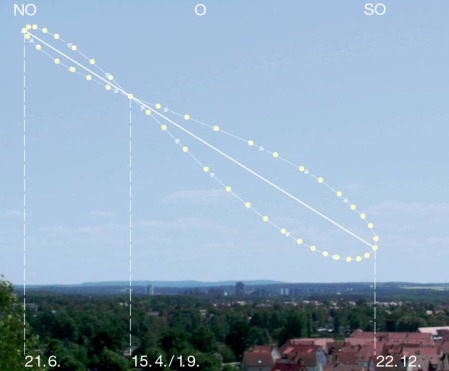
The journey of the sun at the same time of day over the course of a year. The figure-eight pattern is called an Analemma
Today, December 22, 2011, is the first official day of Winter and by definition the shortest day of the year — even though it’s not the earliest sunset or latest sunrise — in the northern hemisphere. Perhaps we should mark the occasion, as our distant ancestors did, with some sort of recognition and related social ceremony, celebrating and welcoming the sun as it moves back to beckon plants and animals into the light of quickening Spring? Oh, wait, yeah, Christmas and all … well, anyway, some researchers at Notre Dame are still thinking of the hot summer sun and all the free energy, about 4 trillion terrawatts to be precise, and ways to make it easier for consumers to get at it. One solution, solar-cell paint!
(TGDaily) — The ‘Sun-Believable’ paint uses semiconducting nanoparticles to produce energy – and while it’s nowhere near as efficient as the current standard, it’s inexpensive and easy to produce in large quantities … “We want to do something transformative, to move beyond current silicon-based solar technology,” says professor Prashant Kamat, who led the research. “By incorporating power-producing nanoparticles, called quantum dots, into a spreadable compound, we’ve made a one-coat solar paint that can be applied to any conductive surface without special equipment.”
Sci-fi writers have envisioned this for decades. It’s good to see science fact catching up as the post carbon world looms ahead. And it makes sense: why worry about building fusion reactors, or sucking out the last gooey bits of ancient caramelized alga, when there’s already a massive fusing core of hydrogen conveniently located overhead topped off with enough fuel to last 5 billion more years?

A mere 1% conversion… but that will improve, yes it will. But even at 1%, imagine the possibilities! You could smear that paint EVERYWHERE! Hell, with that sort of technology, you could potentially coat driveways and rooftops as well, not to mention cars, parking lots… roads might get damaged too quickly, but still, it’s possible. Only one percent? Sure, but there’s a bloody lot of surface area out there.
I wonder how they orient the particles to get distinct +/- poles on the covering?
@ raymoscow
Considering this isn’t done in other amorphous materials solar-electric tech (at least not in the way we tend to think of these things), we’d probably need to redesign your question. You have a good one, though.
Well, Lorax, let’s hope it comes in more than one color.